Why fabulous olive oil evokes the prettiest church in France for me
How an olive harvesting feast in Provence led to a heart-warming tale about a clandestine map, a glistening basilica, and wild riches
I just made a wonderful salad of arugula, chevre, and pear, dressed with nothing but olive oil. And that little taste treat made me recall how much I adore Mediterranean “green-gold,” which led to me thinking about a secret map, then about stunning Sacre Couer, the gleaming white basilica that peers down upon Paris from the top of Montmartre.
I realize that this is not a logical connection for most people. However, the happy link in my memory banks between olives, a map, and the glistening French church will soon become clear.
A decade ago, while spending a spring in Paris, I stumbled upon a beautiful store — Première Pression Provençal— that was all about olives, specifically those that come from that hilly, forested sweep of southern France known as Provence. The store was the latest venture of Olivier Baussan, the man who’d also started L’Occitane because he wanted to keep the traditions of Provence alive.
The wood shelves were lined with sleek silver canisters of wildly tasty oils — pressed from green olives, purple olives, and black olives, the range of colors determined by how long the fruits were left on the trees to ripen. Tasting the resulting oils, I discovered that the green variety produces oil that is herbaceous and grassy; those made from the purple variety are smoother; and the oils from the black olives are nuttier, creamier, almost buttery, and my favorites.
There were over 100 types of olives in Provence alone, said Christophe Tournebize, the store manager, whose long salt-n-pepper hair was pulled back in a tidy ponytail. His store featured extra-virgin, first-press oils from small producers who rejected industrial processes, picking olives by hand and cold-pressing them in small batches at nearby mills. Even though Spain and Italy are the heavyweights in production by volume, olives from Provence make some of the world’s most sublime oils, he said.
And while the sharp, grassy Vert made from green olives is commonly pressed across Mediterranean countries, Provence is the only place where mills routinely press the two other traditional styles — the soft-n-nutty Mûr (from the mature mauve olives), and the sweetly fruity Noir (from the fully-ripened black olives).
Just then a large, gruff character entered and handed him a bag. Christophe’s face lit up.
“The best part of Saturday has arrived!” said Christophe, leading me to a small table outside the store and opening the bag. Inside were oysters.
“Fresh from the coast of Brittany,” he said, pouring me a glass of crisp white wine, as his friend pulled out a knife and began shucking. Every Saturday, said Christophe, his friend stopped by with his fresh-from-Brittany gift. And every Saturday while I was in Paris, I put in an appearance, too, partaking in their oysters-on-the-sidewalk party and feeling, for a moment, rather French.
One Saturday, Christophe began waxing poetic about the festivities surrounding the olive harvests across France, telling me about autumn’s first recolte of tight green olives, when friends, family, and neighbors gathered together to pluck, shake, and rake the fruit from trees and afterward a festive party ensued.
And then he mentioned his friends in Provence — who lived in a hilltop village called Bonnieux — where they had an olive grove and were famous for their festive recolte in November.
So I wrangled an invitation — not knowing that the adventure would lead me to a family legend involving a secret map, a special light-catching white stone, the Second French Empire of Napoleon III — and ultimately one of the most beautiful sights in Paris.
On the road
I rounded up photographer Fabien Dany for a road trip — and we spent the first night at a fetching bed and breakfast, Château Juvenal, surrounded by vineyards. The estate also had an olive grove, but the owners — Anne Marie and Bernard Forestier — had already harvested their olives.
The miracle, said Anne Marie, was that their olive groves even existed. A biting frost in 1956 destroyed the trees; the French government instructed farmers to plant grapes in their place and rip out any olive trees that survived.
“But the olive tree never dies,” said Anne Marie, mentioning its deep roots. Many decades after the groves had been destroyed, olive trees pushed back up just after the Forestiers had bought the property. This time the government supported the olives’ reappearance.
The next day Fabien and I set off further south, winding up and up on a narrow curving road, past a village of stone, to the groves of Richard and Julie-Marie Favre. Walking towards their cliff-perched house, we saw a curious sight: numerous “half-bodies” on ladders, the top halves of said bodies being hidden in rustling silvery trees, from which olives were raining onto nets and tarps spread out on the ground.
The five dozen olive pickers had been at it since morning, stopping only for a hearty wine-filled lunch, and by the time we arrived the trees were nearly raked bare of their fruit. The olive-laden tarps and the nets were carried to several nearby trucks which were soon heaping with olives.
Among the half-hidden bodies was Olivier Baussan, owner of Première Pression Provençal, which wasn’t surprising since some of the most popular oils in his store came from this grove. As he raked the last green fruits from the branches, he told me that after the frost of 1956, olives had nearly disappeared from Provence. But new, young producers were bringing back olive groves — and pressing the fruits the old way.
“An olive renaissance is underway here,” said Baussan. “There’s new excitement about olives.” The region’s 200 mills were suddenly packed and oil production was soaring. “Take, for example, Richard,” he said, pointing at the fellow driving a tractor, hauling a bouncing load of green fruit along the rows of trees. “Three years ago, he produced 300 liters of oil. This year he’s producing 4,000.”
Richard Favre’s main profession is building houses — he owns a construction company. But when his father died and he inherited his parents’ home, he added “farmer” to his resume, because he revered the Mediterranean tradition of growing olives for oil.
Every year people from all parts of the world descended on his estate, Richard told me, while loading tarps of the olives onto the back of an open truck that was soon filled to the brim. And then he hopped into the driver’s seat, Fabien beside him, and followed by a few other trucks, they descended down, down, down to the nearby mill, where the olives were washed and destemmed and ultimately smashed on a stone mill.
At the house, darkness quickly enveloped the olive grove, and the party began — a jazz band started playing as plates of foie gras and fine cheese and little tartlets began swirling and the wine began flowing. I chatted with some visiting Americans, a trio from Brussels, an Australian or two, some Parisians, and other people who had flown in from Asia.
Just then, however, the trucks — now filled with olive oil that was mere minutes old — pulled up and everyone assembled at a long table and plates heaped with meats and vegetables were passed around along with bottles of the glistening verdant oil, that tasted peppery and grassy with a hint of mineral, and — the mark of a fine olive oil — tickled the back of your throat when it went down.
The feasting and the partying went on until the wee hours.
Somewhere in between drinking, feasting, and dancing, I overheard a man who, despite partaking in the harvest, was clad in a 3-piece suit and speaking French with what struck me as a German accent. I discerned that he was speaking of a book that he’d published — about the rooftops of Paris.
So I butted right into his conversation. How did it happen, I asked, that a German had written a book about Parisian roofs? This provoked incredulous looks and laughter from his friends.
The man in the suit told me that he had a company that specialized in repairing the rooftops of buildings that had been built in the mid-1800s during the construction boom initiated by Emperor Napoleon III. And he informed me that he wasn’t German, but France-born-and-raised.
“Why do you speak French with a German accent?” I asked.
He laughed. “It’s not a German accent — it’s high French,” he said. “The French spoken by nobles.”
“You’re a noble?” I asked.
He nodded.
I’d met presidents and prime ministers, movie makers, and rock stars, but I’d never encountered a noble. “Well, m’lord, I besiege you,” I said, “tell me what does the life of a noble entail? Hunts in the forest? Shooting small innocent birds?”
He affirmed that such were among his recreational pursuits as was frequent horseback riding. I was intrigued, so we made a date to meet the next day.
****
After a trip to a farmers’ market to buy black truffles, the noble drove me to his newly built home overlooking the hills of Luberon. While he was showing me around the spacious, 3-story abode wrapped with huge windows, he picked up a framed picture from a table.
“Would you like to see my childhood home?” he asked.
I expected the picture would show something swanky — a fabulous villa or gardened manor. But the framed photo was much more spectacular, showing a huge castle with turrets and towers, that appeared to sprawl across several acres and bore three distinctly designed wings.
The original castle, constructed in the 14th century, had been built by medieval knights, he explained, pointing to the towers on the left, with additions made by an early industrialist and another section added in the late 1800s by his great-grandfather.
“And how did your great-grandfather come to own a castle like this?” I asked.
“Ah, the story started with his father,” the noble began.
The Noble Family Legend
The noble said he was descended from peasants — and their situation, never easy, grew more desperate in 1815, the year Napoleon I abdicated, for the second time, and was exiled to St. Helena. Their difficulties stemmed from the strange weather caused by the eruption of a volcano in Indonesia, which that year and the next was blamed for cold temperatures worldwide; 1816 was known far and wide as “the year without a summer.”
Across Europe, crops failed, and on the family farm in central France, wheat was stunted, grapes didn’t ripen, and corn rotted on the stock. The yields were so alarmingly low that the family sent their eldest son — let’s call him Henri — to Paris to work as a stone cutter.
Henri set off on the three-day walk to the French capital, camping along the way. On the second night, as night fell, he spread out his blanket on the banks of the river, and the next morning as he headed off, he spotted a most vibrant bit of limestone, one that reflected light dazzlingly. Wandering further, he discovered a hidden quarry of the nearly iridescent stone.
He hastily sketched a map and resumed his journey to Paris. That spring when he walked back to the family farm to help plant the crops, he again stopped by the quarry, which remained undiscovered. He passed by several times a year for decades — happy to see that the quarry remained his secret alone. Even after he married and had sons of his own, he never mentioned it to a soul. But he was never able to gather enough money to buy the land that held the quarry.
On his deathbed, Henri asked to speak alone with his eldest son, let’s call him Pierre, finally revealing his discovery and telling him the location of the secret map. “Buy that quarry!” were Henri’s last words.
Pierre, who also worked as a stone cutter in Paris in bad harvest years, tried and tried, saving his money as best he could, but couldn’t succeed in saving enough to purchase the land that held the quarry.
However, in 1852, President Louis-Napoleon Bonaparte — the first French president to be elected with universal male suffrage — announced that he would instead become emperor. And one of his goals was to improve the lot of the working poor. He approved new banks, which for the first time offered loans to the lower classes.
It took years, but Pierre finally got a loan and opened his limestone quarry. Alas, much of the construction boom that followed Napoleon III’s renovation of Paris was over. However, in 1870, when Napoleon III declared war on Prussia — a stupid move that caused his Second Empire to crash overnight — Paris shortly thereafter erupted in a localized civil war that caused vast destruction across the city.
What’s more, when the dust finally settled from what had been several truly horrific years, some Parisians felt that they had suffered “a divine punishment for the moral decline of the country since the French Revolution.” The only way to restore favor, they believed, was to build a grand basilica on the butte of Montmartre, overlooking the sinful capital city. And for this edifice, they wanted the purest, most glistening limestone in France.
Before long, hundreds of oxen were every day hauling the shimmering limestone from the newly opened quarry in central France to Paris to build the magnificent Sacre Coeur. The noble’s great-grandfather was awarded a title and grew so rich he bought the nearby castle, adding a wing of his own design.
“Great story,” I said when the noble finished. “Is it true?”
He shrugged, saying only that such was the tale passed down for generations.
So I’m unsure of its veracity, and the map that yielded vast wealth long ago disappeared, but it’s a story that makes me happy every time that I think of it — and I think of it whenever I taste fine olive oil, which I do nearly every day.




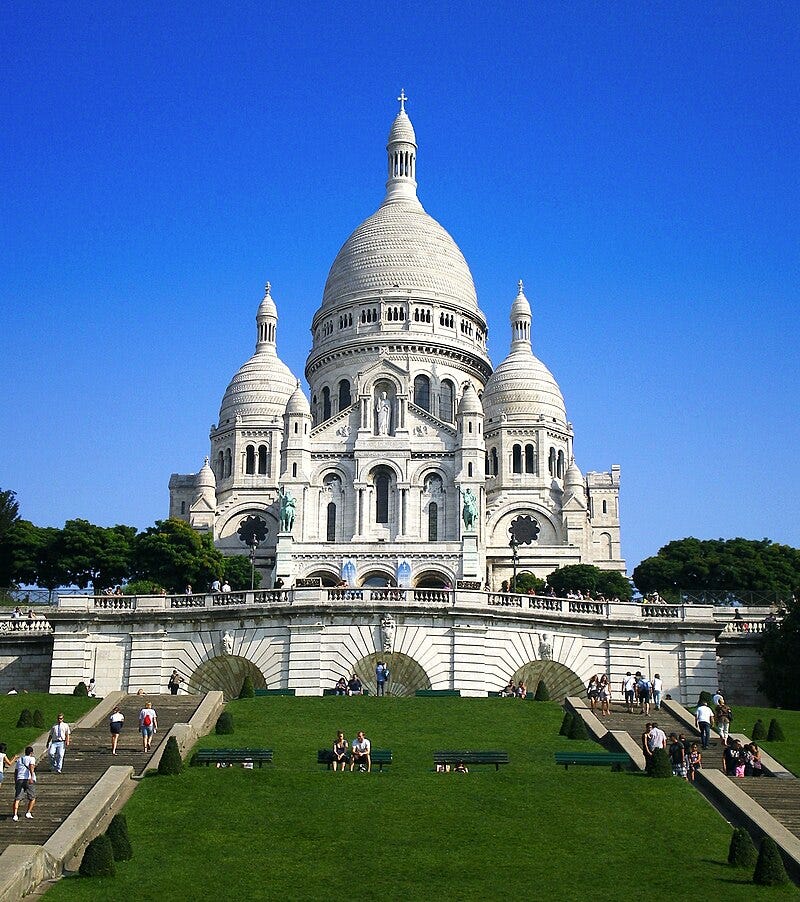
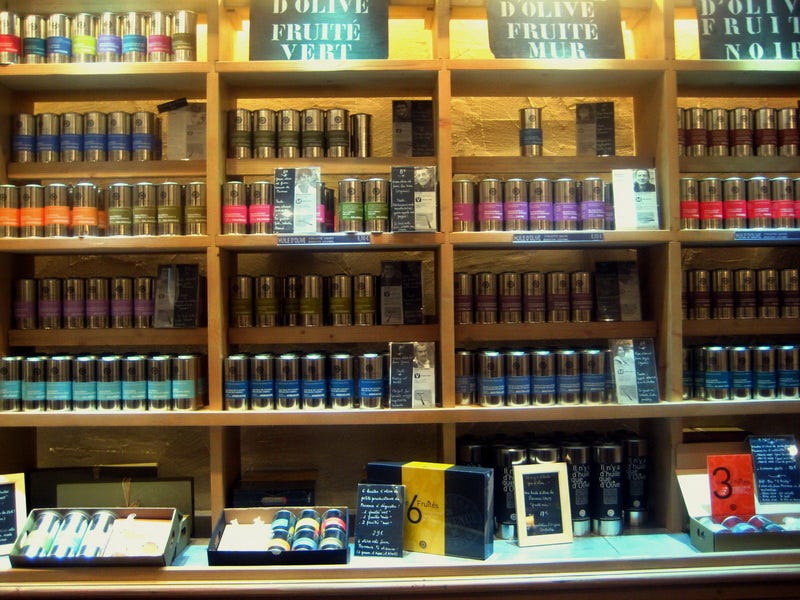
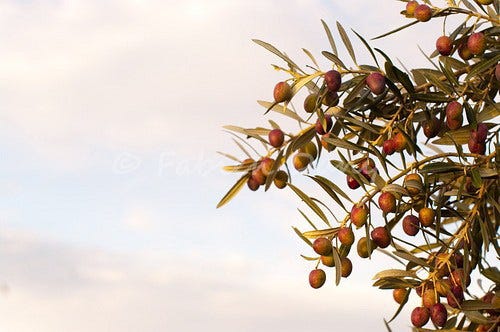
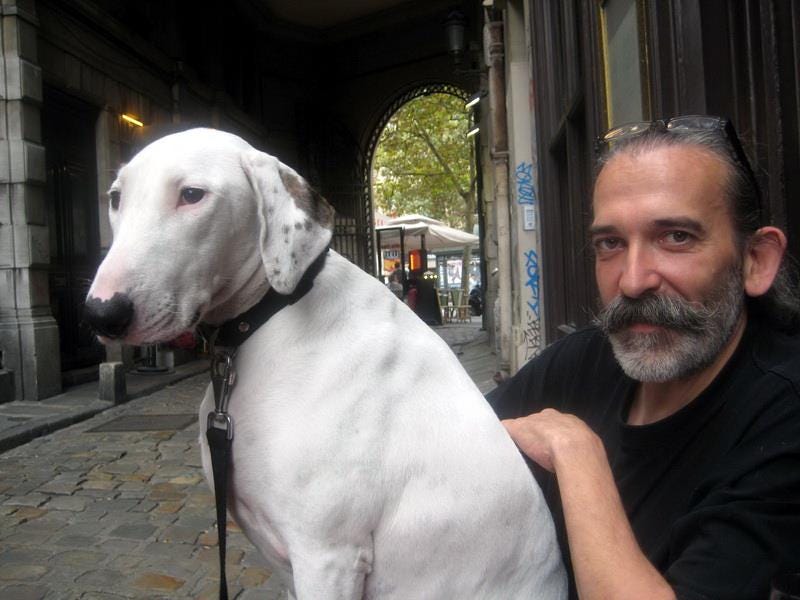


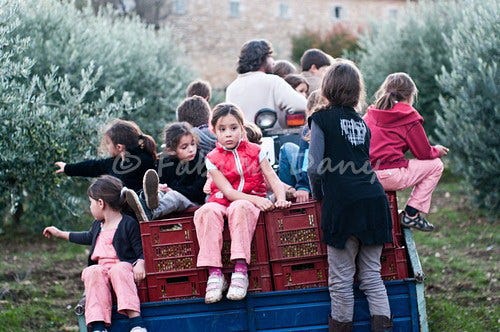
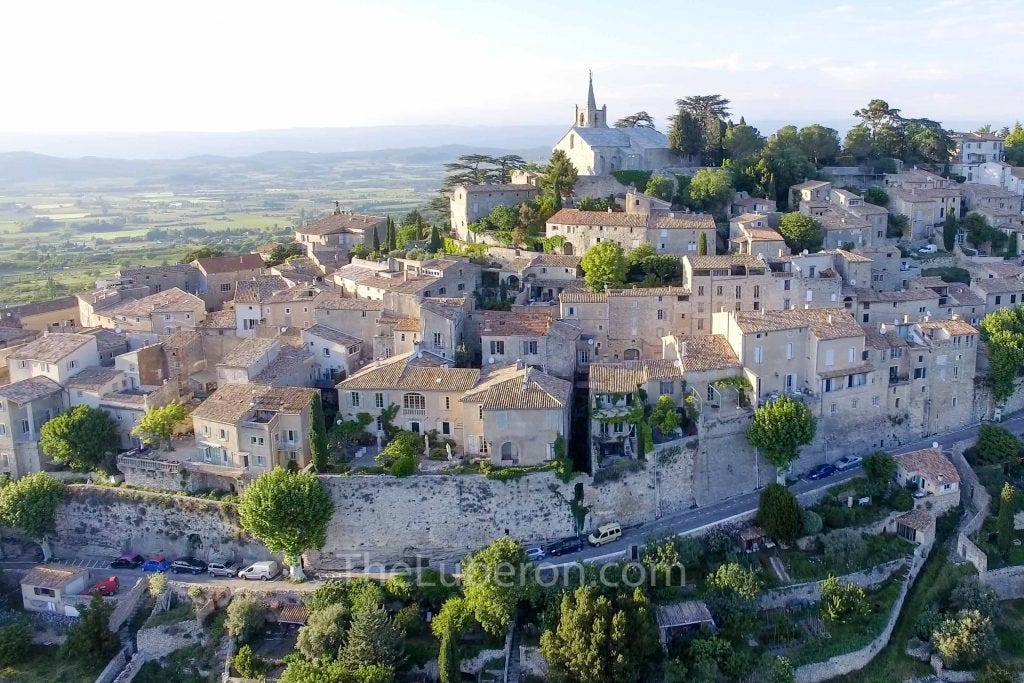


The prices of olive oil skyrocketed lately, so there are a lot of thieves breaking and entering supermarkets just to get the new gold, which as you know it's the basis of Mediterranean cuisine. There's nothing more delicious than a big toast of bread –rustic and crunchy bread– dressed with olive oil, rubbed with garlic and tomato, with leaves of fresh basil on top, and fetta cheese.